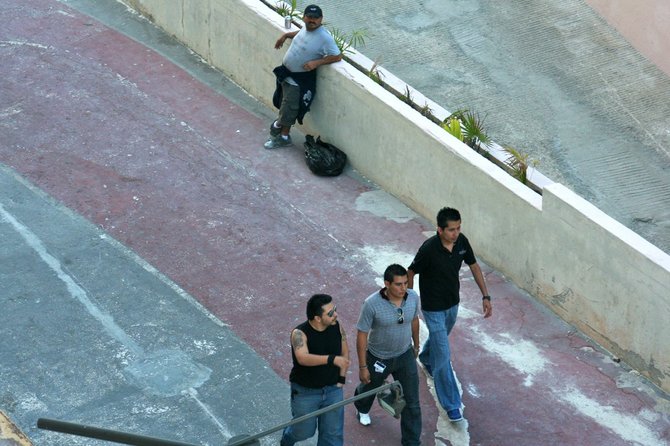 Facebook
Facebook
 X
X
 Instagram
Instagram
 TikTok
TikTok
 Youtube
Youtube

“It’s totally safe, man,” said Sergio as he swigged his beer bottle and sucked on a cigarette. “Women walk around at night. Kids play in the streets. No problem.”
My friends in Pittsburgh were horrified that I was visiting Mexico for spring break. Why, they wondered, would I pick now to spend a few days in Mexico, when assassination and kidnapping were daily travails? Didn’t I worry about the cartels? The abductions? Corrupt cops?
But this was Cancun, far from the troubles of northern Mexico. It was also the real Cancun, a functional little town that few Norteamericanos ever explore. I decided to stay near the bus station, a good distance from the all-inclusive resorts, where I could practice my Spanish and converse with locals. Cancun didn’t resemble most of the Yucatan, but neither was it Hard Rock Cafés and Coco Bongo.
Sergio, a potbellied man in cargo shorts, spent his days connecting backpackers to hostels. He could also arrange tours, and he carried a binder full of postcards and Xeroxed itineraries. Like most Cancunos, he’d grown up somewhere else, in Mexico City, where much of his family still resided.
“You know my sister is in town,” Sergio suddenly said. “She just came in today. I haven’t seen her for five years, man.” We clinked Dos Equis bottles and I wished him a happy reunion.
As I wandered toward the plaza, I thought about the people I’d met in Cancun. Most were service workers, and many had lived briefly in the U.S. Their families and friends were scattered across North America, living in various states of legality, and it was easy for a man like Sergio to spend years away from relations.
The streets were dark but throbbed with movement. Stray dogs lurked, men laughed on doorsteps, women in papery dresses held hands as they slipped between cars. The plaza was alive with singers and scurrying children and squad cars. Even the orange-tinted sky was pierced by hurled glow sticks.
This was the Mexico Americans so often forgot, a place for families and steaming food and dancing on the cobblestone. The town of Cancun struck a delicate balance – between the poverty and desperation of small-town Mexico and the sterile luxury of beachfront hotels.
As I walked back through the narrow streets, a little tipsy, I found myself glancing over my shoulder. The hum of electric lines and the clicking of a lock made me wary of pursuit. But that wasn’t Cancun. I’d do the same thing in my own neighborhood.
Sus casas, I thought, son como mi casa.


“It’s totally safe, man,” said Sergio as he swigged his beer bottle and sucked on a cigarette. “Women walk around at night. Kids play in the streets. No problem.”
My friends in Pittsburgh were horrified that I was visiting Mexico for spring break. Why, they wondered, would I pick now to spend a few days in Mexico, when assassination and kidnapping were daily travails? Didn’t I worry about the cartels? The abductions? Corrupt cops?
But this was Cancun, far from the troubles of northern Mexico. It was also the real Cancun, a functional little town that few Norteamericanos ever explore. I decided to stay near the bus station, a good distance from the all-inclusive resorts, where I could practice my Spanish and converse with locals. Cancun didn’t resemble most of the Yucatan, but neither was it Hard Rock Cafés and Coco Bongo.
Sergio, a potbellied man in cargo shorts, spent his days connecting backpackers to hostels. He could also arrange tours, and he carried a binder full of postcards and Xeroxed itineraries. Like most Cancunos, he’d grown up somewhere else, in Mexico City, where much of his family still resided.
“You know my sister is in town,” Sergio suddenly said. “She just came in today. I haven’t seen her for five years, man.” We clinked Dos Equis bottles and I wished him a happy reunion.
As I wandered toward the plaza, I thought about the people I’d met in Cancun. Most were service workers, and many had lived briefly in the U.S. Their families and friends were scattered across North America, living in various states of legality, and it was easy for a man like Sergio to spend years away from relations.
The streets were dark but throbbed with movement. Stray dogs lurked, men laughed on doorsteps, women in papery dresses held hands as they slipped between cars. The plaza was alive with singers and scurrying children and squad cars. Even the orange-tinted sky was pierced by hurled glow sticks.
This was the Mexico Americans so often forgot, a place for families and steaming food and dancing on the cobblestone. The town of Cancun struck a delicate balance – between the poverty and desperation of small-town Mexico and the sterile luxury of beachfront hotels.
As I walked back through the narrow streets, a little tipsy, I found myself glancing over my shoulder. The hum of electric lines and the clicking of a lock made me wary of pursuit. But that wasn’t Cancun. I’d do the same thing in my own neighborhood.
Sus casas, I thought, son como mi casa.
Comments